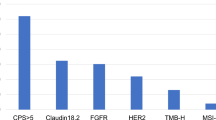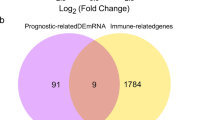Abstract
PD-1, PD-L1, CTLA-4, TIM-3, and LAG-3, crucial immune checkpoint molecules in the tumor microenvironment, identify as key targets for cancer immunotherapy. There is a correlation between immune cells and epithelial-mesenchymal transition (EMT)-related genes expression in varies human cancers. In this study, we aimed to investigate the probable association between expression of immune checkpoints and EMT in esophageal squamous cell carcinoma (ESCC) with clinical treats for providing the new therapeutic targets and prognostic value for the disease. Quantitative real-time PCR was used to investigate the gene expression profile of immune checkpoints (PD-1, PD-L1, CTLA-4, TIM-3, and LAG-3) and EMT (TWIST1 and MMP-13) genes based on the mRNA expression levels in 51 ESCC tissues. The upregulation of CTLA-4, PD-1, PD-L1, TIM-3, LAG-3, MMP-13, and TWIST1 were observed in 31.37%, 29.41%, 21.56%, 39.21%, 25.49%, 60.78%, and 56.86% of ESCC cases at the mRNA level, respectively. Dysregulation of immune checkpoints was related to lymph node involvement, stage of tumor progression, and depth of tumor invasion (P < 0.05). While overexpression of MMP-13 and TWIST1 was associated with lymph node involvement, stage of tumor progression, and grade of tumor differentiation (P < 0.05). The mRNA expression of immune checkpoint genes was significantly correlated to each other's (P = 0.000). Of importance, the data explored the significant association between the concomitant expression of immune checkpoints and EMT-related genes with each other in a variety of clinicopathological traits (P < 0.05). Consequently, immune checkpoints were positively correlated with EMT status in ESCC. The correlation between tumor immune microenvironment with the elevation of multiple immune checkpoints and EMT status may help to identify potential biomarkers for the simultaneous clinical use of multiple immune checkpoints blockade and other immunotherapies approaches for advanced ESCC patients.





Similar content being viewed by others
Data availability
The data that support the findings of this study are available from the corresponding author upon reasonable request.
References
Barooei R et al (2015) Evaluation of thymic stromal lymphopoietin (TSLP) and its correlation with lymphatic metastasis in human gastric cancer. Med Oncol 32(8):217
Barriga V et al (2019) The complex interaction between the tumor micro-environment and immune checkpoints in breast cancer. Cancers 11(8):1205
Bustin SA et al (2009) The MIQE guidelines: minimum information for publication of quantitative real-time PCR experiments. Oxford University Press, Oxford
Cao Y et al (2013) Tim-3 expression in cervical cancer promotes tumor metastasis. PLoS ONE 8(1):e53834
Chae YK et al (2018) Epithelial-mesenchymal transition (EMT) signature is inversely associated with T-cell infiltration in non-small cell lung cancer (NSCLC). Sci Rep 8(1):1–8
Chen DS, Mellman I (2013) Oncology meets immunology: the cancer-immunity cycle. Immunity 39(1):1–10
Chen L et al (2017) PD-L1 expression promotes epithelial to mesenchymal transition in human esophageal cancer. Cell Physiol Biochem 42(6):2267–2280
Couzin-Frankel J (2013) Cancer immunotherapy. American Association for the Advancement of Science, Washington
Dai C et al (2016) Concordance of immune checkpoints within tumor immune contexture and their prognostic significance in gastric cancer. Mol Oncol 10(10):1551–1558
Dong H et al (2002) Tumor-associated B7–H1 promotes T-cell apoptosis: a potential mechanism of immune evasion. Nat Med 8(8):793–800
Forghanifard MM et al (2012) Expression analysis elucidates the roles of MAML1 and Twist1 in esophageal squamous cell carcinoma aggressiveness and metastasis. Ann Surg Oncol 19(3):743–749
Fridman WH et al (2012) The immune contexture in human tumours: impact on clinical outcome. Nat Rev Cancer 12(4):298–306
Gao Y et al (2020) Heterogeneity of immune microenvironment in ovarian cancer and its clinical significance: a retrospective study. OncoImmunology 9(1):1760067
Gholamin M et al (2009) Overexpression and interactions of interleukin-10, transforming growth factor β, and vascular endothelial growth factor in esophageal squamous cell carcinoma. World J Surg 33(7):1439
Huang T-X, Fu L (2019) The immune landscape of esophageal cancer. Cancer Commun 39(1):79
Huang R-Y et al (2017) Compensatory upregulation of PD-1, LAG-3, and CTLA-4 limits the efficacy of single-agent checkpoint blockade in metastatic ovarian cancer. Oncoimmunology 6(1):e1249561
Jiao XL et al (2014) Clinical significance of serum matrix metalloproteinase-13 levels in patients with esophageal squamous cell carcinoma (ESCC). Eur Rev Med Pharmacol Sci 18(4):509–515
Jiao R et al (2019) Immune checkpoint inhibitors in esophageal squamous cell carcinoma: progress and opportunities. OncoTargets Ther 12:6023
Jung YS et al (2012) TIMP-1 induces an EMT-like phenotypic conversion in MDCK cells independent of its MMP-inhibitory domain. PLoS ONE 7(6):e38773
Kang Y, Massagué J (2004) Epithelial-mesenchymal transitions: twist in development and metastasis. Cell 118(3):277–279
Kassardjian A, Shintaku PI, Moatamed NA (2018) Expression of immune checkpoint regulators, cytotoxic T lymphocyte antigen 4 (CTLA-4) and programmed death-ligand 1 (PD-L1), in female breast carcinomas. PLoS ONE 13(4):e0195958
Ku GY (2019) The current status of immunotherapies in esophagogastric cancer. Surg Oncol Clin N Am 26:277–292
Leng C et al (2016) Relationship between expression of PD-L1 and PD-L2 on esophageal squamous cell carcinoma and the antitumor effects of CD8+ T cells. Oncol Rep 35(2):699–708
Li C-W et al (2012) Epithelial–mesenchymal transition induced by TNF-α requires NF-κB–mediated transcriptional upregulation of Twist1. Cancer Res 72(5):1290–1300
Liacini A et al (2003) Induction of matrix metalloproteinase-13 gene expression by TNF-α is mediated by MAP kinases, AP-1, and NF-κB transcription factors in articular chondrocytes. Exp cell Res 288(1):208–217
Liang J et al (2018) The correlation between the immune and epithelial-mesenchymal transition signatures suggests potential therapeutic targets and prognosis prediction approaches in kidney cancer. Sci Rep 8(1):1–9
Lin Y-T, Wu K-J (2020) Epigenetic regulation of epithelial-mesenchymal transition: focusing on hypoxia and TGF-β signaling. J Biomed Sci 27(1):1–10
Lin EW et al (2016) The tumor microenvironment in esophageal cancer. Oncogene 35(41):5337–5349
Lou Y et al (2016) Epithelial–mesenchymal transition is associated with a distinct tumor microenvironment including elevation of inflammatory signals and multiple immune checkpoints in lung adenocarcinoma. Clin Cancer Res 22(14):3630–3642
Mahmoudian RA, Forghanifard MM (2020) Crosstalk between MEIS1 and markers of different cell signaling pathways in esophageal squamous cell carcinoma. Mol Biol Rep 47:3439
Mahmoudian RA, Abbaszadegan MR, Gholamin M (2017) Applying subtractive hybridization technique to enrich and amplify tumor-specific transcripts of esophageal squamous cell carcinoma. Pathol Oncol Res 23(2):271–279
Mahmoudian RA et al (2019) MEIS1 knockdown may promote differentiation of esophageal squamous carcinoma cell line KYSE-30. Mol Genet Genomic Med 7(7):e00746
Mak MP et al (2016) A patient-derived, pan-cancer EMT signature identifies global molecular alterations and immune target enrichment following epithelial-to-mesenchymal transition. Clin Cancer Res 22(3):609–620
McNiel EA, Tsichlis PN (2017) Analyses of publicly available genomics resources define FGF-2-expressing bladder carcinomas as EMT-prone, proliferative tumors with low mutation rates and high expression of CTLA-4, PD-1 and PD-L1. Signal Transduct Target Ther 2(1):1–8
Noman MZ et al (2017) The immune checkpoint ligand PD-L1 is upregulated in EMT-activated human breast cancer cells by a mechanism involving ZEB-1 and miR-200. Oncoimmunology 6(1):e1263412
Ohigashi Y et al (2005) Clinical significance of programmed death-1 ligand-1 and programmed death-1 ligand-2 expression in human esophageal cancer. Clin Cancer Res 11(8):2947–2953
Pardoll DM (2012) The blockade of immune checkpoints in cancer immunotherapy. Nat Rev Cancer 12(4):252–264
Paulsen E-E et al (2017) CTLA-4 expression in the non-small cell lung cancer patient tumor microenvironment: diverging prognostic impact in primary tumors and lymph node metastases. Cancer Immunol Immunother 66(11):1449–1461
Peng Y-X et al (2020) EMT-related gene expression is positively correlated with immunity and may be derived from stromal cells in osteosarcoma. PeerJ 8:e8489
Ruiz-Villalba A et al (2017) Amplification of nonspecific products in quantitative polymerase chain reactions (qPCR). Biomol Detect Quantifi 14:7–18
Saleh R et al (2019) Prognostic value of Lymphocyte-Activation Gene 3 (LAG3) in cancer: a meta-analysis. Front Oncol 9:1040
Schmittgen TD, Livak KJ (2008) Analyzing real-time PCR data by the comparative C T method. Nat Protoc 3(6):1101
Sedighi M et al (2016) Matrix metalloproteinase-13-a potential biomarker for detection and prognostic assessment of patients with esophageal squamous cell carcinoma. Asian Pac J Cancer Prev 17(6):2781–2785
Shan B et al (2016) TIM-3 promotes the metastasis of esophageal squamous cell carcinoma by targeting epithelial-mesenchymal transition via the Akt/GSK-3β/Snail signaling pathway. Oncol Rep 36(3):1551–1561
Shrestha R et al (2020) TNF-α-mediated epithelial-to-mesenchymal transition regulates expression of immune checkpoint molecules in hepatocellular carcinoma. Mol Med Rep 21(4):1849–1860
Sobin LH, Gospodarowicz MK, Wittekind C (2011) TNM classification of malignant tumours. Wiley, Hoboken
Solinas C et al (2019) Significance of TIM3 expression in cancer: from biology to the clinic. Semin Oncol 46:372–379
Tan TZ et al (2014) Epithelial-mesenchymal transition spectrum quantification and its efficacy in deciphering survival and drug responses of cancer patients. EMBO Mol Med 6(10):1279–1293
Terry S et al (2017) New insights into the role of EMT in tumor immune escape. Mol Oncol 11(7):824–846
Thar Min AK et al (2018) Epithelial-mesenchymal transition-converted tumor cells can induce T-cell apoptosis through upregulation of programmed death ligand 1 expression in esophageal squamous cell carcinoma. Cancer Med 7(7):3321–3330
Thompson JC et al (2020) Gene signatures of tumor inflammation and epithelial-to-mesenchymal transition (EMT) predict responses to immune checkpoint blockade in lung cancer with high accuracy. Lung Cancer 139:1–8
Tu L et al (2019) Assessment of the expression of the immune checkpoint molecules PD-1, CTLA4, TIM-3 and LAG-3 across different cancers in relation to treatment response, tumor-infiltrating immune cells and survival. Int J Cancer 147:423–439
Wang L et al (2018a) EMT-and stroma-related gene expression and resistance to PD-1 blockade in urothelial cancer. Nat Commun 9(1):1–12
Wang B et al (2018b) Effects of combination of anti-CTLA-4 and anti-PD-1 on gastric cancer cells proliferation, apoptosis and metastasis. Cell Physiol Biochem 49(1):260–270
Wang W et al (2019) Characterization of LAG-3, CTLA-4, and CD8+ TIL density and their joint influence on the prognosis of patients with esophageal squamous cell carcinoma. Ann Transl Med 7(23):776
Xie J et al (2016) Expression of immune checkpoints in T cells of esophageal cancer patients. Oncotarget 7(39):63669
Xiong D, Wang Y, You M (2019) Tumor intrinsic immunity related proteins may be novel tumor suppressors in some types of cancer. Sci Rep 9(1):1–16
Xu D et al (2019) PD-L1 expression is regulated By NF-κB during EMT signaling in gastric carcinoma. OncoTargets Ther 12:10099
Zhang X-F et al (2016) Cytotoxic T lymphocyte antigen-4 expression in esophageal carcinoma: implications for prognosis. Oncotarget 7(18):26670
Zhang H et al (2019) Integrated bioinformatics analysis identifies hub genes associated with the pathogenesis and prognosis of esophageal squamous cell carcinoma. BioMed Res Int 2019:1–9
Zhao Y et al (2020) Significance of TIM-3 expression in resected esophageal squamous cell carcinoma. Ann Thorac Surg 109:1551–1557
Acknowledgements
The authors acknowledge the colleagues at the Division of Human Genetics, Avicenna Research Institute, MUMS, for preparing ESCC tissue specimens.
Funding
This study was supported by a Grant from Vice-chancellor of Mashhad University of Medical Sciences (#960741).
Author information
Authors and Affiliations
Corresponding author
Ethics declarations
Conflict of interest
The authors declare that they have no competing interests.
Informed consent
Informed consent was obtained from all individual participants included in the study.
Additional information
Publisher's Note
Springer Nature remains neutral with regard to jurisdictional claims in published maps and institutional affiliations.
Rights and permissions
About this article
Cite this article
Mahmoudian, R.A., Mozhgani, S., Abbaszadegan, M.R. et al. Correlation between the immune checkpoints and EMT genes proposes potential prognostic and therapeutic targets in ESCC. J Mol Histol 52, 597–609 (2021). https://doi.org/10.1007/s10735-021-09971-3
Received:
Accepted:
Published:
Issue Date:
DOI: https://doi.org/10.1007/s10735-021-09971-3




